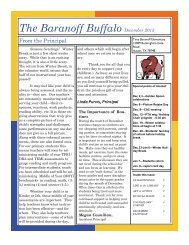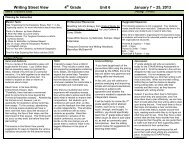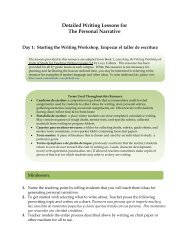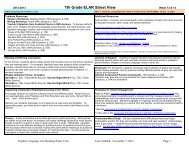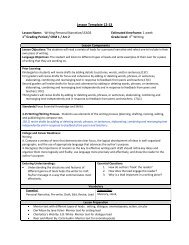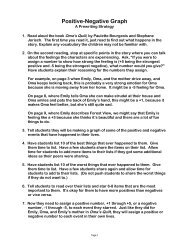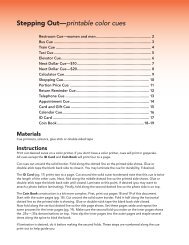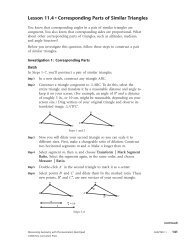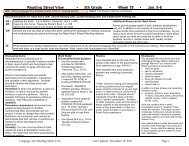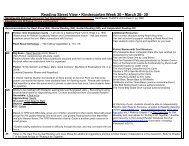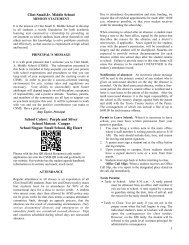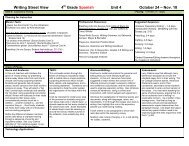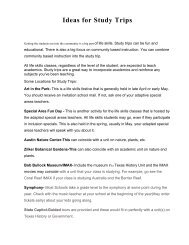Writing Street View 5 Grade Unit 7 March 25 - June 5, 2013
Writing Street View 5 Grade Unit 7 March 25 - June 5, 2013
Writing Street View 5 Grade Unit 7 March 25 - June 5, 2013
- No tags were found...
Create successful ePaper yourself
Turn your PDF publications into a flip-book with our unique Google optimized e-Paper software.
Prewriting:Technology Application: www.learning.com lessons will help support the process of searching for information and practicing good “digital citizenship” bycorrectly citing sources of facts included in student articles. Lessons helpful for this unit are found in the section entitled “Web Browsing Basics.” They include:Browsing URLs, Inappropriate Content Discussion, Keyword Searches, Sourcing and Ethics, Examining Content, Better Safe than Sorry. There are also areview and quiz for the section.<strong>Writing</strong> Process: Expository ReportReview the characteristics of expository writing by sharing a fewwell-written research-based articles from the newspaper, children’smagazines, or online sources like Scholastic. Sources for examplesof expository articles include local newspapers and magazines, NationalGeographic for Kids, Discovery Kids, Time for Kids, Scholastic News.Attachments for this page (in green) can be found here.Organizing:Texas Write Source says, “The thesis statement tells what the report is all about. A good thesisstatement starts with an interesting topic and then focuses on a controlling idea about the topic.” (p. 341)“Tell Me More…” Peer Conferencing – Writers give feedback to a peer to help them add moreideas to their writing.Expert List and Gallery Walk - This prewriting activity will guide yourwriters to think about their interests, hobbies, and things they enjoydoing outside of school. Students will share their ideas with a smallgroup, then with the whole group to find a ‘unique angle’ for their topic.Write What You Know - Students commit to one topic and begin arough draft about that topic. This rough draft is considered aprewriting because it will undergo many revisions and reorganizations.Define an “expository article” as a nonfiction piece of writing thatreports facts, realistic ideas, or real events. It quotes what an expertsays about the topic and it may also include the thoughts, ideas andopinions of the writer.While it is tempting to guide your students toward good academictopics for them to research, writing experts agree that when writerschoose their own topics, they see their work as more fun andmeaningful. Writers want to put time and effort into pieces that areimportant to them. Janet Angelillo, author of The Struggling Writer(2010), outlines these reasons for allowing students to choosetheir own topic in writing: When students choose their topics, the writing focusmoves from the teacher to the students. They know more about topics they choose to write about. They tend to care about their writing when the topic hasmeaning to them. We can teach them more about writing itself when we arenot “pulling teeth” to get them to write.We make them better writers—and thinkers—in the long run whenwe teach them to think deeply about an idea of their own.Discuss “audience,” and who the students think will be interested in reading their article. Theaudience should guide the style and content of their essay.What Do I Want my Audience to Learn From my Article? Open your writers’ minds to thinkoutside the box of ‘writing to inform’.Develop a Thesis A strong thesis statement will give the students the backbone of their article. It is onthis backbone that they will build the body of their piece.Key Word Searches: Finding Information on the Internet Students use Key Words to searchthe Internet for reliable, and readable sources of information about their topic.Use either of these Web Site Evaluation Forms to facilitate a discussion about finding reliableresources on the internet:http://www.readwritethink.org/files/resources/lesson_images/lesson149/ElectronicSources.pdfhttp://www.readwritethink.org/files/resources/lesson_images/lesson328/evalform.pdfSee these links for support in doing online research: Anatomy of a Search, Better Searches. BetterResults. Finding Reliable Sources AISD Online Resources Searching with Google (This one is a 12page teacher resource book on using Google K-12)Ways to order the information - Use the information from your research topic (or a student’s topic) to‘think aloud’ about how to decide which organizational structure will work best for the thesis, supportingstatements, and the type of evidence collected. Chronological order Strongest evidence first and leave a strong memory last Make categories Support one side, then the other Least to most important, using transition words
Final Draft/Publishing:Adding Text Features to the Expository ArticleIn order for your students to present their expository articles toan audience effectively, they will need to practice their OralPresentation Skills. (You may decide to omit #3 because thewhole purpose of this unit was to write a well-organizedexpository article. Reading it aloud to the audience is aperfectly acceptable way to present written work.)Use a rubric like this one: Oral Presentation Rubric, or modifyit to fit your expectations. Students should practice their oralpresentations, using the guidelines or rubric you created.“Experts” Present their ArticlesCelebrate!The greatest motivation for students to strive to becomebetter writers and to make their pieces the best they can be,is when they share their writing with someone outside of theclassroom.Suggestions for publishing: Students read their expository essays to another classwho is also writing expository compositions. Create an anthology of reports to display in the library ornear the visitor’s chairs in the office. Invite parents and family members to the child’sresearch presentation.Editing:Conferencing:Hold “research conferences” to ensure that studentsare finding adequate and reliable resources. Askstudents to explain to you how they plan to use theinformation they have found. How will the newinformation add to what they already know about thetopic?As writers begin adding research to their drafts, conferwith each writer to make sure they are connectingtheir research to a main point they are making in theirwriting.Confer with writers whose central idea or perspectiveis not clear. Ask, “What do you want to say about thistopic? How do you feel about this topic?” Then usetheir writing and show them how to add statements toclarify their central idea and perspective.You can save time by reading your students’ writing inadvance of your conference with them. Make note ofonly 1-2 revisions you will recommend the writer maketo the content of the writing. Which 1 or 2 changes willmake the biggest impact on this writing?Revising:Drafting:Models of Expository ArticlesDefine paraphrasing, direct quotes, and plagiarismin student friendly language. See this link forteacher definitions: Plagiarism, Citing Sources,Paraphrase, and Direct QuotesAdding Research Using your own expositoryarticle, show students how you might add researchto your writing through direct quotes orparaphrasing.Creating a Bibliography Use the resources youfound to support your own expository article andmodel how to create a bibliography.Peer Editing - Be sure to only include concepts and rules that havealready been taught. Students should work on one element at atime.5th <strong>Grade</strong> Conventions ChecklistUnderstanding the Structure of Expository Articles and Applying Organizational Structures to theExpository Article The author’s purpose is directly related to the organizational structure of the writing. Anappropriate structure will help the author communicate his/her ideas more effectively.Building a Criteria Chart Afterwards, students read their current draft and mark places where they need torevise (according to the class criteria chart.)Revision: Clarity of Central IdeaRevision: Leads and ConclusionsRevision : Coherence and TransitionsRevision: Eliminating the Bad Words in Our <strong>Writing</strong> Create a class list of overused words found in writing, for example, really, like and very.Avoid proper nouns, pronouns, and articles. Ken Macrorie calls these types of words, “The Really Bad Words”. (Notice he uses theword ‘really’ in the title of this list. ‘Really’ is one of the words on this list!)Teacher Notes:Students’ first attempts at writing expository reports will not be perfect. Do not expect perfection! Remember that you are introducing this new type of writing and asthey continue to hear and read examples from your modeling of your own writing, from mentor texts, and from their peers’ writings, they will begin to internalize the wayan expository report sounds. You will need to model, model, model, and keep giving your students opportunities to try again. Soon they will be experts!



